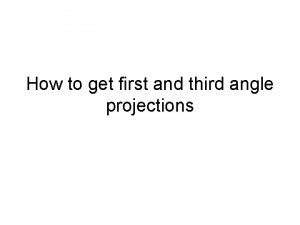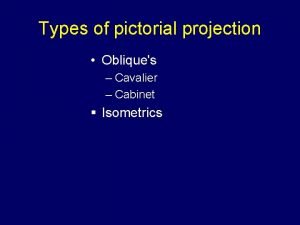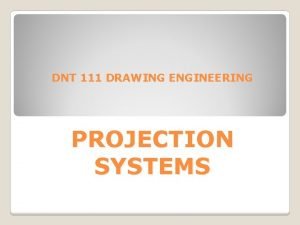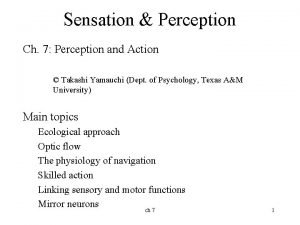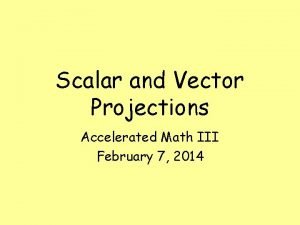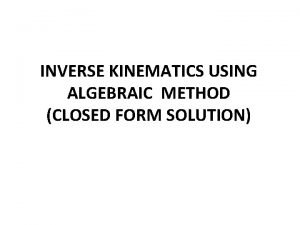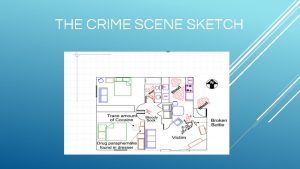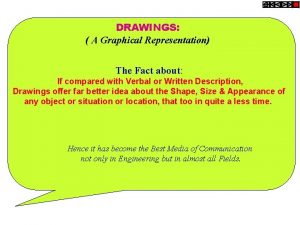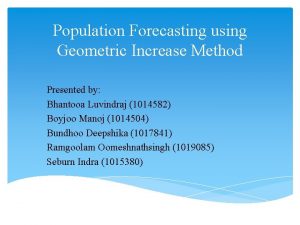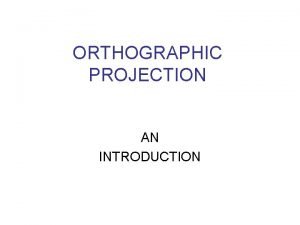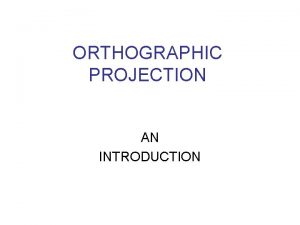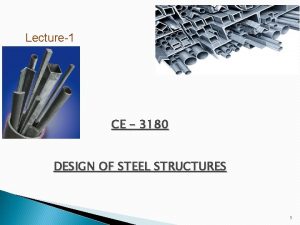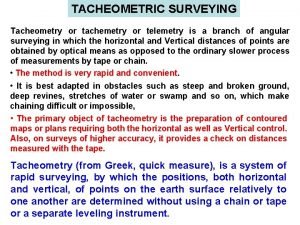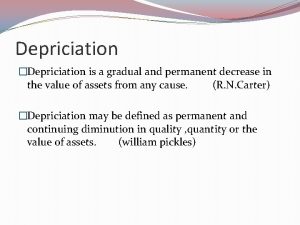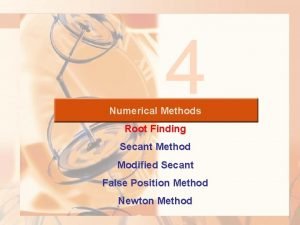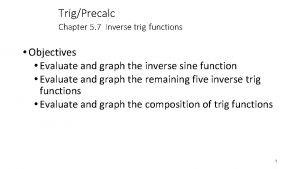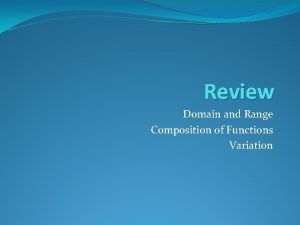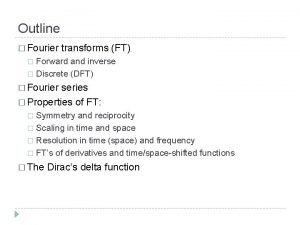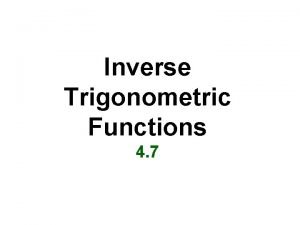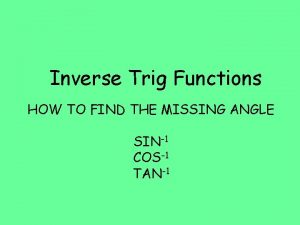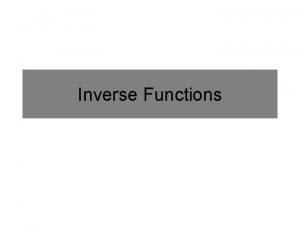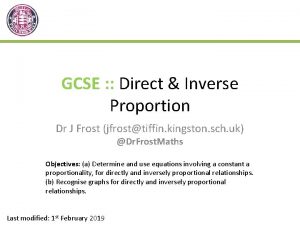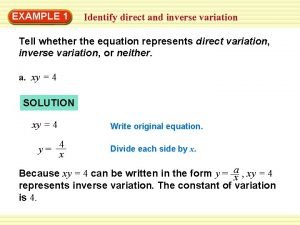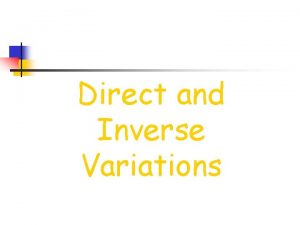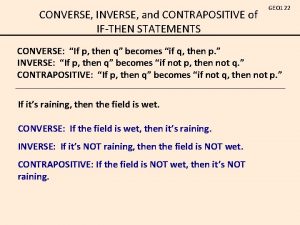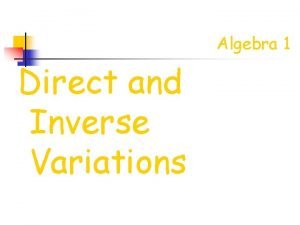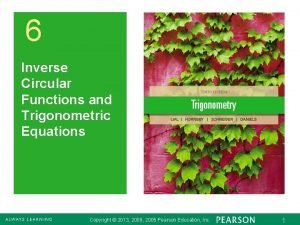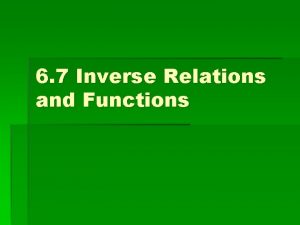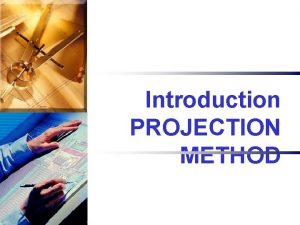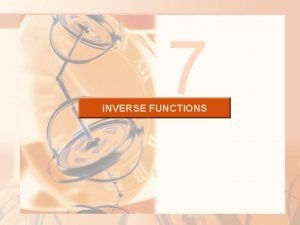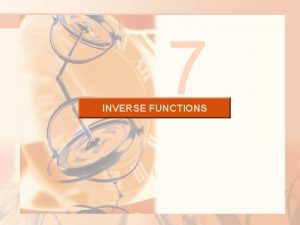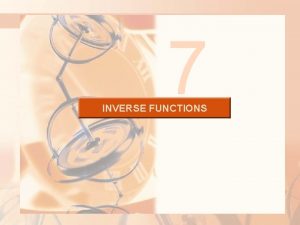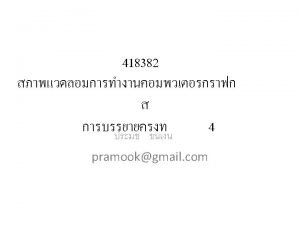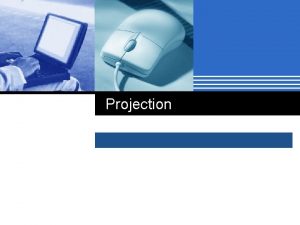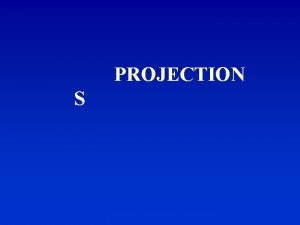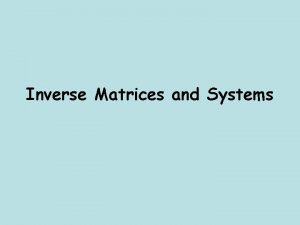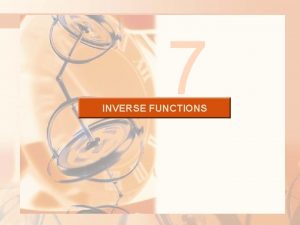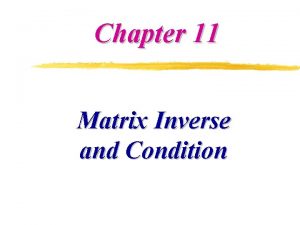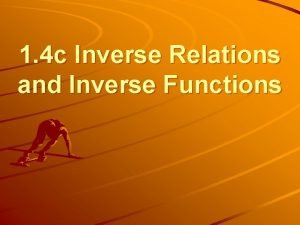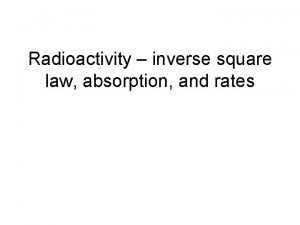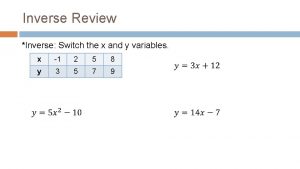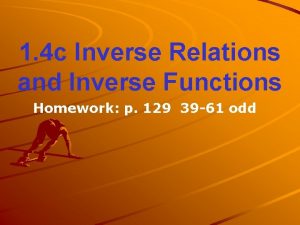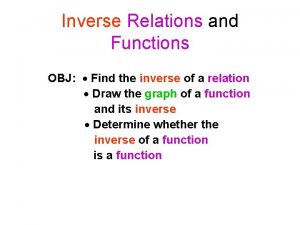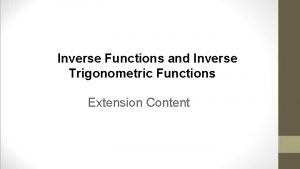Projection and inverse projection as a method of















































- Slides: 47

Projection and inverse projection as a method of reformulating linear and integer H. P. Williams programmes London School of Economics h. p. williams @ lse. ac. uk www. lse. ac. uk/depts/op-research/personal/Williams 1

Example (Maximise z) Subject to: Project out x 1 2

3

How to carry out Projection The following statements are equivalent: Proof Immediate Take (Decision Procedure of Langford for Theory of Dense Linear Order) 4

We can take fi and g i as linear expressions in the other variables (apart from x) The constraints of any linear programme can be put in this form and x eliminated (projected out) But need to combine every inequality of form With every inequality of form Can lead to combinatorial explosion in number of inequalities. Equations and associated variables can be eliminated prior to this by Gaussian Elimination. 5

Example (Maximise z) Subject to: 6

Write in form 7

Eliminate x 1 8

i. e. Have added (in suitable multiples) every inequality in which x 1 has a positive coefficient to every inequality in which x 1 has a negative coefficient 9

C 0 C 1 4 1 1 C 2 1 1 C 3 1 4 C 5 C 4 1 1 1 Can continue process to eliminate x 2 and x 3 This is Fourier-Motzkin. 10

+ - 0 0 C 1 C 2 C 3 C 4 C 5 + - 0 x 2 - - + x 3 - - + -- + + + - Can be shown (Kohler) that if, after n variables have been eliminated, an inequality depends on more than n+1 of original inequalities it is redundant. 11

Can choose which variables to project out and order in which to do so. 12

EXAMPLE OF PARTIAL PROJECTION Benders’ Decomposition Partially project out some variables (for MIP, continuous variables) to give bound on objective (Benders Cut) Potentially very large increase in constraints. Performed partially and iteratively. 13

Application of Projection to Non. Exponential Formulations of the Travelling Salesman Problem Example Sequential Formulation (Miller, Tucker and Zemlin) Constraints and Variables 14

Project out Gives variables all directed cycles A relaxation of Conventional Formulation all proper subsets 15

Other non-exponential formulations give modifications of subtour elimination constraints of (exponential) conventional formulation Single Commodity Flow Formulation gives Modified Single Commodity Flow Formulation 16

Multi Commodity Flow Formulation i. e. of equal strength to Conventional Flow Formulation Time Staged Formulation 17

INVERSE PROJECTION Apply the dual procedures to eliminate constraints (as opposed to variables). Minimise 3 y 2 -y 1 + y 2 -4 y 1 + y 2 5 -y 1 + 2 y 2 3 subject to: 2 y 1 + y 1, y 2 0 18

Write in form Minimise subject to: 2 y 1 + 3 y 2 4 y 0 -5 y 0 y 2 - y 3 = 0 + y 2 - y 4 = 0 2 y 2 - y 5 = 0 1 -3 y 0 - y 1 + y 0 y 1 + + y 1 = y 1, y 2, y 3, y 4, y 5 0 Eliminate homogeneous constraints by adding columns (in suitable multiples) where 19 coefficients have opposite sign.

Implemented by a transformation of variables. 4 y 0 4 u 1 y 1 4 u 2 u 3 y 2 u 4 y 3 First homogeneous constraint vanishes. 20

4 y 0 = 4 u 1 + 4 u 2 y 1 = 4 u 1 + u 3 y 2 = u 3 + u 4 y 3 = 4 u 2 + u 4 Substitute 21

Model becomes 8 u 1 + 5 u 3 + 3 u 4 subject to - u 1 + 5 u 2 + 2 u 3 + u 4 - y 4 = 0 - 7 u 1 - 3 u 2 + u 3 + 2 u 4 - y 5 = 0 u 1 + u 2 = 1 Minimise u 1, u 2, u 3, u 4, y 5 0 22

Repeat with transformations to eliminate second and third homogeneous constraints. Results in Minimise 43 w 1 + 5 w 2 w 1 + 38/ + 3 w 3 + 15 w 4 + 3 w 5 w 3 + w 4 = 1 w 1, w 2, w 3, w 4, w 5 0 23

Applying corresponding transformations to identity matrix gives relation between final and original variables w 1 w 2 y 0 1 0 y 1 11 1 y 2 7 1 y 3 0 0 y 4 13 2 y 5 0 1 w 3 w 4 w 5 1 0 3 0 0 8/ 5 1 9 1 0 0 1 0 7 2 1 7/ 3 13/ 3 24

Gives all vertices and extreme rays of model C: w 1 = 1 gives y 1 (11 w 2 gives extreme ray ( 1 B: w 3 = 1 gives (7/3 A: w 4 = 1 gives ( 0 w 5 gives extreme ray ( 0 y 2 7) Objective = 43 1) 8/ ) 3 Objective = 38/3 5) Objective = 15 1) 25

NB: Transformations mirror those of (Primal) Projection. Redundant transformations if variable depends on more than n+1 of original variables after n constraints eliminated. 26

Example of Inverse Projection (On some constraints) Dantzig-Wolfe Decomposition . 27

Project out subproblems into single (convexity) constraints 1111…. 1 1111…. . . . 1111…. 1 28

Also Modal Formulations i. e. Variables represent extreme modes of processes rather than quantities NB Inverse Projection is not the same as Reverse Projection (not well defined). 29

INTEGER PROJECTION The Elimination of Integer Variables a, b positive integers x an integer variable f and g linear expressions Need to state condition “a multiple of ab lies between bf and –ag” 30

Can be done in a finite way by Alternatively Presburger Arithmetic I. e. Arithmetic “without multiplication”) 31

Projection of an IP may not produce an IP in lower dimension e. g. Project out x 2 32

But if coefficient of x is unity in one of inequalities can apply F-M elimination NB The projection of an IP generally does not result in an IP in a lower dimension 33

INTEGER PROJECTION Example Minimize z i. e. 34

Eliminate 35

Eliminate x 2 (taking into account congruence relations) 36

Optimal Solution a Lattice Point within Polytope. Reduces problem from an infinite number to a finite number of solutions. 37

C 2 C 3 C 1 38

Inverse Integer Projection Example Minimize z Subject to: 39

40

Eliminate constraint 1 by a transformation of variables 41

Leads to: Minimise Subject to: Eliminate constraints 42

Leads to: Minimise Subject to: Optimal LP Solution. w 4 = 3220 Objective = 4. 5 N. B. Could replace congruence conditions by Mixed Integer Constraints. Feasible Solutions defined by Convexity Constraint + Congruence Conditions Illustrates Hilbert Basis result 43

Alternatively we could scale variables and write in form Minimise Subject to: corresponds to the extreme ray 44

Projection and Sign Patterns + - Can remove columns and all constraints in which non-negative entry. : + or - 0 0 : : 0 0 Can remove constraints and all variables in which non-negative entry 45

Can add constraints in suitable multiple and remove variable Eg Network Flow can remove node Integer Variable (and other variables integer) Can regard variable as continuous And generalisations of above 46

REFERENCES 1. K. P. Martin Large Scale Linear and Integer Optimization : A Unified Approach, Kluwer 1999 2. Porta Version 2, Free Software Foundation, Boston 1991 3. H. P. Williams (1986) Fourier’s Method of Linear Programming and its Dual, Am. Math, Monthly, 93, 681 -94 4. H. P. Williams (1976) Fourier-Motzkin Extension to Integer Programming Problems, Journal of Combinatorial Theory, 21, 118 -123 5. H. P. Williams (1983) A Characterisation of all Feasible Solutions to an Integer Programme, Discrete Applied Mathematics, 5, 147 -155 47
 1st angle projection and 3rd angle projection difference
1st angle projection and 3rd angle projection difference Cavalier vs cabinet
Cavalier vs cabinet Orthographic projection of isometric drawing
Orthographic projection of isometric drawing Angle of projection
Angle of projection Mirror neurons
Mirror neurons Scalar projection vs vector projection
Scalar projection vs vector projection Objectives of symposium
Objectives of symposium Closed form solutions
Closed form solutions Cofactor method inverse
Cofactor method inverse Z-transform formula
Z-transform formula Bilingual method meaning
Bilingual method meaning What must be included on a crime scene sketch
What must be included on a crime scene sketch A graphical representation of different views of an object.
A graphical representation of different views of an object. Shoulder lawrence method
Shoulder lawrence method Exploded/cross projection sketch
Exploded/cross projection sketch Geometric increase method example
Geometric increase method example Superimposed dimensioning
Superimposed dimensioning Compass point method
Compass point method Orthographic projection
Orthographic projection Orthographic projection introduction
Orthographic projection introduction Visual rays in perspective drawing
Visual rays in perspective drawing Metode terbuka
Metode terbuka Working stress method and limit state method
Working stress method and limit state method Wet gum method examples
Wet gum method examples Permanent adjustment of a theodolite
Permanent adjustment of a theodolite Tacheometry formula
Tacheometry formula In-situ soap method of emulsion preparation
In-situ soap method of emulsion preparation Emulsifying agent
Emulsifying agent Fixed installment method and diminishing balance method
Fixed installment method and diminishing balance method What is reiteration method in surveying
What is reiteration method in surveying Difference between bracketing and open methods
Difference between bracketing and open methods Modified secant method example
Modified secant method example Direct method and grammar translation method
Direct method and grammar translation method Domain and range of sin inverse x
Domain and range of sin inverse x Domain and range of an inverse function
Domain and range of an inverse function Forward and inverse fourier transform
Forward and inverse fourier transform Sin to inverse sin
Sin to inverse sin How to use inverse trig functions to find angles
How to use inverse trig functions to find angles Inverse relations and functions
Inverse relations and functions Dr frost interior and exterior angles
Dr frost interior and exterior angles Inverse variation
Inverse variation Direct and inverse variation
Direct and inverse variation Inverse variation
Inverse variation Derivative of inverse function
Derivative of inverse function Inverse of a statement
Inverse of a statement What is the difference between direct and inverse variation
What is the difference between direct and inverse variation Inverse circular functions
Inverse circular functions 6-7 inverse relations and functions
6-7 inverse relations and functions
